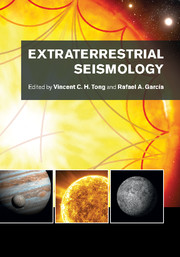Book contents
- Frontmatter
- Contents
- List of contributors
- Preface
- Acknowledgements
- List of abbreviations
- Planetary seismology: High risk, high return
- A bright outlook for helio- and asteroseismology
- Part I Observation and space missions
- Part II Data and physical parameters
- Part III Modeling approaches
- Part IV Discoveries of physical structures and processes
- Part V Interdisciplinary research involving planetary and astrophysical sciences
- 16 Diskoseismology of accretion disks
- 17 Numerical simulations of magnetoconvection and helioseismology
- 18 Impact seismology on terrestrial and giant planets
- 19 Angular momentum transport in stars: From short to long time scales
- 20 From the Sun to the distant stars, and back: Future research directions
- 21 Stellar dynamics: Rotation, convection, and magnetic fields
- 22 Sunquakes: Helioseismic response to solar flares
- 23 Seismic waves in small bodies: Sources and propagation
- Part VI Interdisciplinary research involving terrestrial seismology
- References
- Index
18 - Impact seismology on terrestrial and giant planets
from Part V - Interdisciplinary research involving planetary and astrophysical sciences
Published online by Cambridge University Press: 05 July 2015
- Frontmatter
- Contents
- List of contributors
- Preface
- Acknowledgements
- List of abbreviations
- Planetary seismology: High risk, high return
- A bright outlook for helio- and asteroseismology
- Part I Observation and space missions
- Part II Data and physical parameters
- Part III Modeling approaches
- Part IV Discoveries of physical structures and processes
- Part V Interdisciplinary research involving planetary and astrophysical sciences
- 16 Diskoseismology of accretion disks
- 17 Numerical simulations of magnetoconvection and helioseismology
- 18 Impact seismology on terrestrial and giant planets
- 19 Angular momentum transport in stars: From short to long time scales
- 20 From the Sun to the distant stars, and back: Future research directions
- 21 Stellar dynamics: Rotation, convection, and magnetic fields
- 22 Sunquakes: Helioseismic response to solar flares
- 23 Seismic waves in small bodies: Sources and propagation
- Part VI Interdisciplinary research involving terrestrial seismology
- References
- Index
Summary
Short review of impact seismic records in the Solar System
Impact structures affect all planetary surfaces in the Solar System and especially those not resurfaced by recent tectonic processes or fast erosion. Planetary seismology and remote sensing are the tools used to monitor the dynamics of large impact processes and associated shock waves, in a variety of conditions, from the airless Moon to the atmosphere-protected Earth.
Meteorites and bolides on Earth
The largest impact ever instrumentally recorded occurred in the early days of seismology. This was the famous great Siberian meteor (Ben-Menahem, 1975) with an energy estimated to be about 12.5 megatons (1 ton of TNT = 4.185 × 109 J). It was recorded by two Russian seismic stations at about 1000 km and 5000 km, in addition to pressure records.
The development of worldwide infrasound and seismic networks today allows the detection of much smaller impacts, down to kilogram size in mass. Most of these impacts are detected by their generated airwaves (see Edwards et al., 2008; Edwards, 2008 for a review), either with infrasound sensors or by seismometers detecting the surface displacement generated by the airwave. This acoustic detection can be done not only locally but also at larger distances, thanks to the tropospheric waveguide (Edwards, 2008).
Airwaves are also generating seismic waves through conversion processes at the Earth's surface. This is illustrated by Figure 18.1, which shows the recent seismic observations made by Tauzin et al. (2013) following the Chelyabinsk meteor blast of February 15, 2013. This event generated large Rayleigh surface waves propagating at between 2.7 and 3.5 km/s, with amplitudes corresponding to an event with surface wave magnitude Ms ∼ 3.7. Comparable precursor Rayleigh waves, arriving well before the atmospheric air wave, are also found in many of the impacts reported by Edwards et al. (2008), but of course with smaller amplitudes.
- Type
- Chapter
- Information
- Extraterrestrial Seismology , pp. 250 - 263Publisher: Cambridge University PressPrint publication year: 2015
- 3
- Cited by



